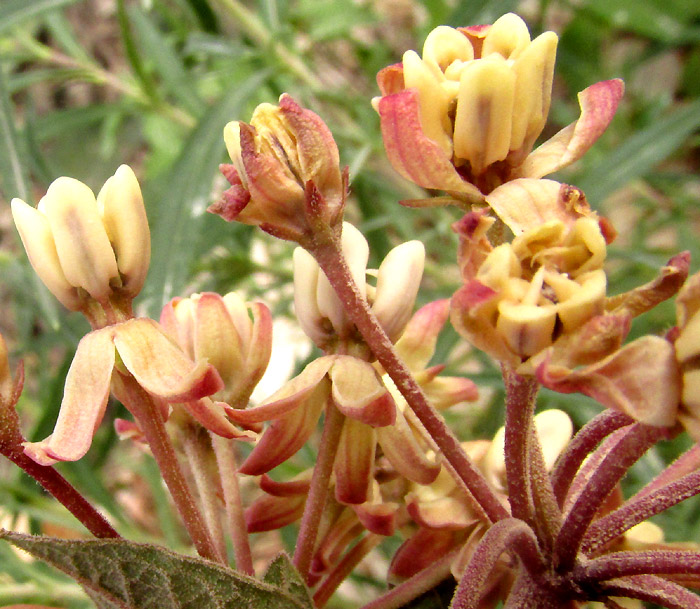Excerpts from Jim Conrad's
Naturalist Newsletter
Entry from field notes dated June 29, 2023, taken along one-lane gravel road in valley between Puerto del Zenthé and Chavarrías in mountainous area with a maze of roads too complex to say how to get there; in general it's in the mountains of east-central Querétaro state, municipality of Cadereyta de Montes, 12 straight-line kms due east of Vizarrón de Montes but much farther by twisting roads; juniper-scrub forest; limestone bedrock; elevation ~2840m (~9300 ft), Querétaro, MÉXICO, (N20.84604°, W99.60655°)
ASCLEPIAS NOTHA

In a semi-open spot of juniper-dominated scrubby vegetation grazed by roaming cattle, the above milkweed flourished among limestone rocks. Among its milkweed features were its unusual-shaped flowers being arranged in somewhat spherical, umbel-type inflorescences -- umbels having flowers on stalks of nearly equal length arising from a common point -- its stout leaves arranged in pairs at stem nodes, its height and its general fleshy appearance. Milkweeds are members of the over-200-species-strong genus Asclepias of the big Dogbane Family, the Apocynaceae. They're called milkweeds because their torn flesh bleeds white, milky latex.

The pale, reddish-pink color displayed on the above flowers also is common among milkweed species. The above blossoms display different stages of maturity, the flower at the left fully receptive to pollinators, the one to its right still in the bud stage, and the one to that flower's right just beginning to open its pinkish sepals.

The above flower exhibits the absolutely unique structure of Asclepias flowers: five sepals spreading below the corolla; five shoe-shaped hoods forming a corona; five sharp-tipped horns arching over the blackish thing, and; the blackish thing being the gynostegium, an amazing physical fusion of five male stamens with the female style and stigma. Milkweed species provide endless variations on such features as hood shape and relative size to the gynostegium, horn length, gynostegium shape, flower color, etc. The above flowers show no particularly unusual features; maybe the flower stalks, or pedicels, are a little longer and slenderer than usual.

Leaves on a few milkweed species are very slender, even needlelike, but this species' blades are broad ones. They're conspicuously soft-hairy, too, as are the stems, and that's a key feature for identifying the species.

Our topmost picture shows dark green leaf surfaces marked with whiteness, especially along the veins but also in disorganized cobweb patterns. I'm guessing that the white patterns were caused by dust from the nearby limestone-gravel road, the dust wetted by morning dew, then dried into patterns in some place encouraged by matting hairs. The above indicates that blade bottom surfaces may have hairs long enough to clump, but top hairs seem too short.
Fortunately for identification purposes, in 2018 Christopher Ostwaldo Cervantes Meza submitted his thesis at the Autonomous University of Hidalgo State, entitled "Sinopsis del Género Asclepias (Asclepiadoideae, Apocynacee) de Hidalgo, México." Hidalgo state's border lies only about 12 straight-line kms due east of our plant's location, so this treatment probably documented and described all Asclepais species found in our area.
Of the 24 milkweed species documented for this area (68 for Mexico), if you have one growing well over hand high, all its vegetative parts are soft-hairy, the somewhat leathery leaves are about 2/3 as wide as long, with somewhat squared bases on petioles over 5mm long (3/16ths inch), and the whitish corolla's hoods are about 1.25 times longer than the gynostegium, you have ASCLEPIAS NOTHA, with no English or Spanish name applied just to it.
Asclepias notha is endemic just to the uplands of central Mexico, in oak/pine and juniper forests, as well dry grasslands and certain disturbed areas, even roadsides. Though the species is of limited distribution, it's common where it occurs. Cervantes Meza found it to be among the three or four most common milkweeds in Hidalgo.
In the 2008 paper by Ana Mercedes Fernández Brewer and others entitled "Usos de las Especies del Género Asclepias L. (Apocynaceae, Asclepiadoideae), Información del Herbrio Nacional de México, MEXU," it's stated that milkweed species used in traditional Mexican medicine "... contain alkaloids, flavonoids, tannins,and cardiac glycosides and have analgesic, dermatological, laxative, and respiratory properties." Also, that some are considered toxic -- which may have something to do with our plant prospering in a cattle-grazed area.
A 2020 page at the SlowFood.Com website, by Ana L. Teyssier Bautista entitled "Chicle de algodoncillo o hierba de leche," tells us that in Mexico City older folks remember the stems and leaves of Asclepias notha being used as a source of latex, from which chewing gum was made. The sap was poured into constantly stirred containers of hot water, where it curdled, forming chewy balls. The taste was "neutral," or semi-bitter, but pleasant on the palate. The plant's immature pods were peeled and eaten.
Asclepias notha was first collected scientifically by Bonpland during Humboldt and Bonpland's visit to Mexico in 1803 and 1804. However, in 1818 when the German botanist Carl Sigismund Kunth was dealing with specimens from the Humboldt and Bonpland expedition, he designated our plants as Asclepias lanuginosa. However, in 1983 US botanist Doug Stevens noticed that two similar-looking species were being called Asclepias lanuginosa. At that time, Stevens described our plants and named them Asclepias notha.